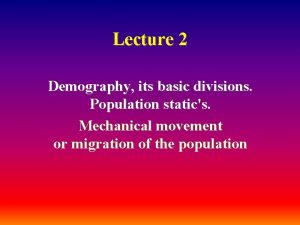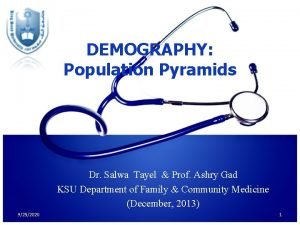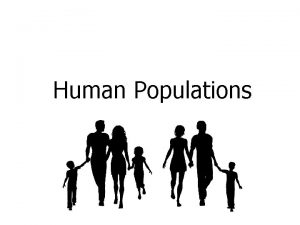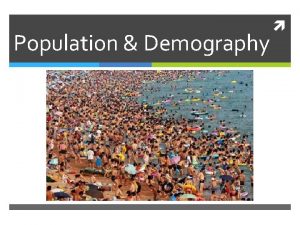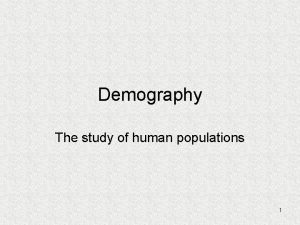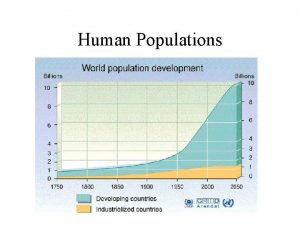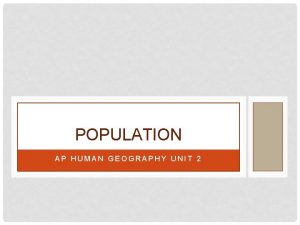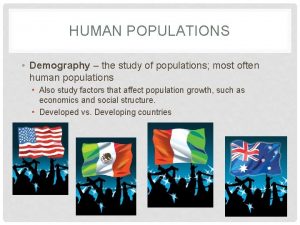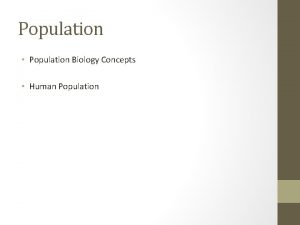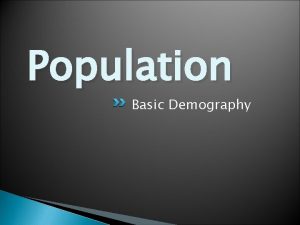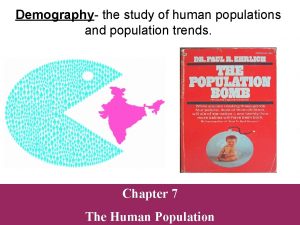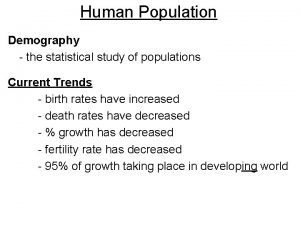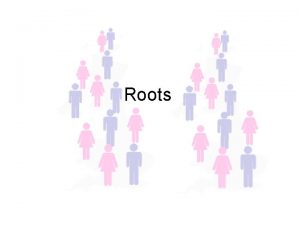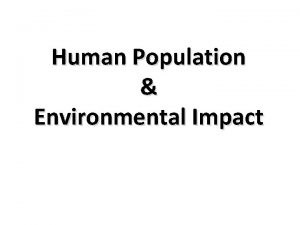The Human Population Kraj Demography Human Populations Demography


























- Slides: 26

The Human Population Kraj

Demography – Human Populations Demography is the study of the characteristics of populations, especially human populations. Demographers study the historical size and makeup of the populations of countries to make comparisons and predictions about growth, economics, and resource needs.

Developed & Developing Countries Two general categories: developed and developing Developed Countries higher average incomes, slower population growth, diverse industrial economies, & stronger social support systems Examples: Canada, USA, France, Germany, Japan Developing Countries lower average incomes, simple & agriculture-based economics, & rapid population growth Examples: Kenya, Haiti, Honduras, Rwanda, Nigeria

Human Population Over Time Exponential growth started in the 1800 s Due to: Decreased death rates Increases in food production Clean water Improvements in hygiene Safe sewage disposal Discovery of vaccines Earth cannot sustain this growth for much longer!

Age Structure Population pyramid of the distribution in terms of age groups and gender. Used for making predictions about population growth. Countries with high rates of growth have more young people. Countries that have slow or no growth have an even distribution of ages in the population.

Fertility Rate The number of births (usually per year) per 1, 000 women of childbearing age (usually 15 to 44). Replacement level fertility is the average number of children women must have in order to “replace” themselves and their partner in the population. Considered 2. 1 (not all children born will survive & reproduce).

Migration Any movement of individuals or populations from one location to another Movement INTO an area=Immigration Movement OUT of an area=Emigration (Exit)

Life Expectancy Average length of time that an individual is expected to live. Most affected by infant mortality. Most determined by the parents’ access to education, food, fuel, and clean water.

The Demographic Transition Model � The general pattern of demographic change from high birth & death rates to low birth & death rates observed in the history of more-developed countries. Caused from increases in industrialization.

Stage One – Pre-Industrial Birth Rate and Death rate are both high. Population growth is slow and changing. Birth Rate is high: Death Rate is high: � Lack of family planning � High levels of disease � High Infant Mortality Rate � Famine � Need for workers in agriculture � Lack of clean water and sanitation � Religious beliefs � Lack of health care � Children as economic assets � War � Competition for food from predators such as rats � Lack of education World in this stage until 1700 s Least Developed Countries today – few remote areas

Stage Two - Transitional Birth Rate remains high. Death Rate is falling. Population begins to rise steadily. Death Rate is falling as a result of: � Improved health care (e. g. Smallpox Vaccine) � Improved hygiene (Water for drinking boiled) � Improved sanitation � Improved food production and storage � Improved transport for food � Decreased infant mortality rates World progress in the 1800 s Today: Bangladesh, Nigeria, Kenya

Stage Three - Industrial Birth Rate starts to fall. Death Rate continues to fall. Population rising. Reasons behind birth and death rate falling: Family planning available Increases in machines reduces need for workers Lower infant mortality rate Increased standard of living Changing status of women World progress in the late 1800 s and early 1900 s Today: China, Brazil

Stage Four – Post Industrial Birth Rate is low. Death Rate is low. Population steady (replacement level) Characteristics of this stage: � Stronger economies � Higher education levels � Better healthcare � Higher proportion of working women � Most developed countries in this stage World progress in the 1900 s to present Today: United States, Sweden, Japan, Britain

Population Trends Populations that have high rates of growth create environmental problems, uses more resources, and can overwhelm infrastructure. Infrastructure is the basic facilities of a country or region, such as roads, bridges, sewers, power plants, subways, schools, & hospitals.

Problems of Rapid Growth Uses resources faster than the environment can renew them. Symptoms of overwhelming populations include suburban sprawl, polluted rivers, barren land, inadequate housing, & overcrowded schools.

Unsafe Water In places that lack infrastructure, the local water supply may be used not only for drinking & washing but for sewage disposal. The water supply then becomes a breeding ground for organisms that can cause diseases.

Impacts on Land Arable land is farmland that can be used to grow crops. Growing populations make tradeoffs between uses for land as agriculture, housing, or natural habitats. Example: Most of Egypt is desert, and less than 4 percent of Egypt’s land is arable. 69 million people are dependent on farming along the Nile River valley. This is also where jobs are located and Egyptians live.

Impacts on Land Urbanization is an increase in the density of people living in urban areas rather than in rural areas. People often find work in the cities but move into suburban areas (suburban sprawl) around the cities. This leads to traffic jams, inadequate infrastructure, & reduction of land for farms and wildlife habitats. Housing within cities becomes more costly, more dense, & in shorter supply.

World Population Growth Current 2018 World Population: 7. 3 Billion (US 326 million) Populations are still growing rapidly in less developed countries, with most of the world’s population now within Asia.

Managing Development & Population Growth In 1994, the United Nations held the International Conference on Population & Development (ICPD) Raising the status of women is key!

Managing Development & Population Growth With these goals, worldwide fertility rates are dropping as shown below.

Population Growth Is Slowing Fertility rates have declined worldwide. Demographers predict that this trend will continue at a medium growth rate. Most countries will have replacement level fertility rates by 2050 stabilizing the population at 9 billion.

Factors Affecting Birth Rates and Fertility Rates The number of children women have is affected by: The cost of raising and educating them. Education and employment opportunities. Availability of contraception and abortion. Availability of pensions. Urbanization. Infant deaths. Marriage age.

Solutions: Influencing Population Size The best way to slow population growth is a combination of: Investing in family planning. Reducing poverty. Elevating the status of women.

Slowing Population Growth In China � Starting in 1970, China used a government-enforced program (One Child Policy) to cut its birth rate in half. � It began being phased out in 2015 and 2016 and now allows two children. � 1. 4 Billion population in 2018 � Problems: � Strong male preference leads to gender imbalance. � Average population age is increasing. � Not enough resources to support population.

Slowing Population Growth In India has tried to control its population growth with little success. Soon to pass China as the largest population. 1. 3 Billion population in 2018 Problems: poor planning, low status of women, extreme poverty, lack of government financial support, and disagreement over the best methods.
 Demographic data definition
Demographic data definition Ap human geography models and theories
Ap human geography models and theories Static demography
Static demography Cso business demography
Cso business demography Elements of demography
Elements of demography Sources of demographic data
Sources of demographic data Components of demography
Components of demography Slash and burn agriculture antonym
Slash and burn agriculture antonym Chapter 4 population ecology worksheet answer key
Chapter 4 population ecology worksheet answer key Population ecology section 1 population dynamics answer key
Population ecology section 1 population dynamics answer key Population ecology section 1 population dynamics
Population ecology section 1 population dynamics Chapter 4 section 1 population dynamics answer key
Chapter 4 section 1 population dynamics answer key Průmysl zlínský kraj
Průmysl zlínský kraj Jihomoravský kraj pohoří
Jihomoravský kraj pohoří Pr��ce ��steck�� kraj
Pr��ce ��steck�� kraj Jihomoravský kraj pohoří
Jihomoravský kraj pohoří Středočeský kraj pracovní list
Středočeský kraj pracovní list Pr��ce ��steck�� kraj
Pr��ce ��steck�� kraj Nitriansky kraj povrch
Nitriansky kraj povrch Pardubický kraj vodstvo
Pardubický kraj vodstvo Průmysl zlínský kraj
Průmysl zlínský kraj Kraj hvala na paznji
Kraj hvala na paznji Literární žánr
Literární žánr Pr��ce ��steck�� kraj
Pr��ce ��steck�� kraj Vanjska kompozicija djela
Vanjska kompozicija djela Košický kraj geografia
Košický kraj geografia Znak karlovarského kraje
Znak karlovarského kraje


